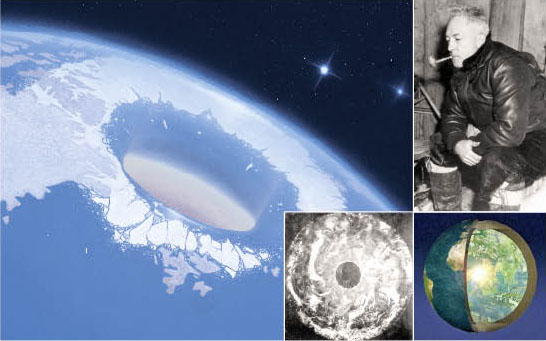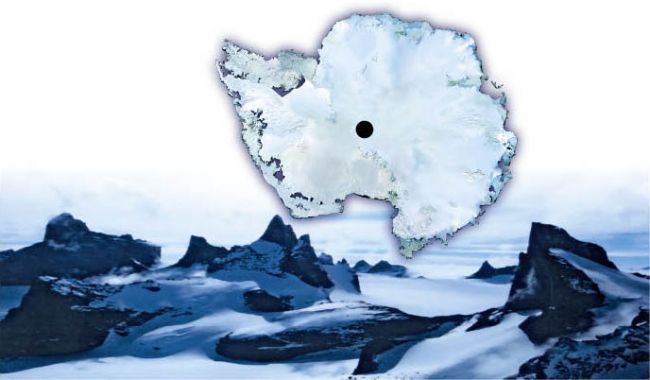Mysterious Antarctica
The land of snow and ice was once a flourishing continent. Although today it is considered inhospitable, it exerts an almost magically attractive force over mankind. It’s no wonder the continent is entrenched in so many legends – from the entrance to fabled “Shangri La” located in the earth’s interior to the obscure stories about secret UFO bases not inhabited by extraterrestrials…
The find is perplexing: personnel from an American NASA laboratory in Antarctica came across a puzzling object in the ice. When they tried to examine it while it was still frozen solid in the block of ice, it thawed despite their intentional cooling. It is a capsule of alien origin and it began transmitting signals, just like those intercepted from the UFO that crashed in Roswell, New Mexico in 1947. Under instructions from Washington, decryption specialist and alien hunter Julien Rome flew to the South Pole where he was able to successfully decipher the signal. But even this could not stop the impending catastrophe. Over his objections, the other scientists opened the capsule, releasing the alien contents from outer space and infecting the team with its presence. For the US government, their worst fears were confirmed: peaceful or not, the presence of aliens alone is a deadly threat to humanity…
If you’re thinking that this whole scenario sounds like something from a bad science fiction film, you’re right on the mark. The 2003 film was called Alien Hunter and it was a complete flop. What is interesting, however, is that Hollywood seems to have gone straight to the offices of US intelligence services for the plot line, because first of all, there actually is an increased level of UFO activity in Antarctica around the South Pole and secondly, the Americans have supposedly already had a military encounter with the aliens and have reason to be fearful of future confrontations.
Operation Highjump
Let’s flashback to 1946. One and a half years after the official end of World War II, a powerful American military fleet under the command of Rear Admiral Richard Evelyn Byrd set off for the South Pole. It was comprised of an aircraft carrier, twelve warships, a submarine, over twenty airplanes and helicopters as well as a crew of four thousand men. It was initially spun as a “scientific operation,” although Byrd himself said in plain language just before their departure on December 2, 1946: “…the purposes of the operation are primarily of a military nature….” He did not divulge any further details.
Aircraft reconnaissance began near Antarctica at the end of January 1947, mostly in the northern area around Queen Maud Land and covered more than 22,000 air kilometers as well as capturing more than 70,000 photographs. Then suddenly something very puzzling happened: the research voyage, scheduled for five months, was abruptly and without public acknowledgement canceled after just two months in what almost seemed to be panic. Equally puzzling is how the operation’s early end was all but covered in a veil of silence in the world press while its beginning had caused such a media stir. What happened?
Dr. Dimitri Filippowitsch, a high-ranking officer in the Russian military thinks he knows: “A torpedo boat destroyer and numerous aircraft were lost and dozens of soldiers and officers were killed. Upon his return Byrd told the members of the special government committee verbatim: ‘In case of a new war the US would be attacked by fighters that are able to fly from one pole to the other with incredible speed.’”
Stranded U-boats
On August 17, 1945, a year and a half before Byrd’s expedition, the German U-boats U-530 and U-977 surrendered in the Argentinean harbor Mar del Plata. According to Filippowitsch: “These were unusual U-boats from the so-called Führer convoy, an extremely secret formation, whose exact mission remains unknown to this day.” Because the crews of the submarines refused to talk, the Americans were able to learn very few details, although the captain of U-530 did supposedly speak of an operation by the name of Walküre 2. In line with this operation, his ship set sail from Kiel in Northern Germany for Antarctica two weeks before the end of the war; thanks to the Walther snorkel, it only had to surface once during the entire voyage across the Atlantic.
On board were passengers whose faces were allegedly masked, as well as important documents from the Third Reich. The captain of U-977, Heinz Schaeffer, confirmed that he sailed the same route with his boat shortly thereafter and in conducting their own research, the Americans realized that numerous German U-boats traveled in the direction of Antarctica during the war. What was the reason for these voyages?
Why the Storm on Antarctica?
Hitler’s Germany was extremely interested in Antarctica beginning in the 30s. Many historians attribute this to the occultist background of the upper echelons of the Nazi party, some of whom where members of the so-called Thule Society. In studying translations of old Tibetan, Indian and Greek texts, they came to (correctly) believe that our earth is hollow and inhabited within. Ultima Thule is supposed to have been the name of the capital city of the continent Hyperborea, older than Atlantis and Lemuria. According to Thule texts, the Hyperboreans were highly technologically and socially advanced. The continent was located in the Norwegian Sea and sunk over the progression of an ice age. During the catastrophe, however, the Hyperboreans dug large tunnels through the earth’s crust using giant machines and settled under what is today the Himalayas. It is said that they named their new kingdom Agharta or Agharti and its capital city Shamballah. The current Dalai Lama XIV as well as lamas from Mongolia and Tibet claim to have known this subterranean kingdom along with The Lord of the World (Rigden Iyepo) living there. Over the millenia, the subterranean kingdom has supposedly spread below the earth's entire surface with giant centers under the Sahara, the Mato Grosso in Brazil, Yucutan in Mexico, Mount Shasta in Northern California and many others.
The members of the Thule Society, hoped to make contact with these fabled inner-earth civilizations, sending out various expeditions – to Tibet, the Andes, the Mato Grosso – and to the North and South Poles where they suspected openings to the earth’s interior to be located. Their belief was influenced by old texts, clandestine knowledge of secret societies and through observations of the laws of nature, where they found hollow bodies, everywhere – in cells, the ovum, atoms, and comets. Even the hermetics helped to convince them that the earth must be a hollow body with their law “as above so below, as within so without, the macrocosm is as the microcosm, and vice versa.”
Their beliefs were further supported by odd reports from polar explorers. For example, the discovery of a warming wind north of the 76th parallel and the fact that birds and other animals are drawn in the direction of the pole, although it is allegedly cold and inhospitable there. They also found gray and colored snow, which revealed volcanic ash and flower pollen when thawed – along with giant animals frozen in the ice which they identified as mammoths, their bellies full of fresh grass. There are also reports of arctic explorers having seen a diffuse second sun.1
In the middle of November 1938, preparations for a German Antarctica expedition were underway when Richard Evelyn Byrd arrived in Hamburg as a guest of the Polar Shipping Association (Polarschiffahrtsgesellschaft) to present his Antarctica film With Byrd at the South Pole. Of the 82 people in the audience, 54 were future members of the ship’s crew. They were there for training purposes, because Admiral Byrd had all but flown over the South Pole in 1929.
Just a few weeks later on December 17, 1938, the MS Schwabenland, an aircraft carrier and a catapult ship under the command of Alfred Ritscher, set sail for the Nazi’s Antarctica expedition, reaching Antarctica on January 19, 1939. With the help of steam-powered catapults, the ship was capable of sending ten-ton aircraft into flight. The pilots flew over a territory of about 600,000 square kilometers in Northern Antarctica (roughly the size of the Third Reich at that time) and photographed nearly 350,000 square kilometers. In flight, the aircraft discharged aluminum rods bearing swastika flags every twenty-five kilometers and named the region they had claimed Neu Schwabenland. After the war, this region was annexed by the Norwegians and renamed Queen Maud Land. There are numerous contradictory assumptions with regards to the true goal of the expedition. The obvious German disinformation propagandized by Göring claimed that the expedition served to secure a food supply for the German people in the event of war, the waters around the Antarctic then teeming with whales.
After the Schwabenland expedition returned home to Germany in early 1939, continuing orders were issued to Karl von Dönitz, Supreme Commander of the U-boat fleet. The mission he and his men were to carry out is still today 90 percent speculation, based on 10 percent information. What is known for certain is that an increasing frequency of German U-boats began setting off in the direction of the South Pole from that point on in order to carry out missions that remain a secret even now. Two alleged statements from Karl von Dönitz are riddles to this day, the first of which reads: “My U-boat operators discovered a real earthly paradise.” Von Dönitz made the second statement in 1943 at the height of the German-Russian War and it is no less mysterious. Filppowitsch quotes: “Germany’s U-boat fleet can be proud that they’ve built an impenetrable fortress for the Führer on the other side of the world.” What was von Dönitz talking about? Did he mean Antarctica, or maybe even the southern region of South America? After all, that is where Hitler escaped to according to various sources.

Richard Byrd during his stay in Antarctica in 1947 when he flew into the inner earth (the painting portrays the North Pole). To the left is a NASA satellite image from the South Pole (1968, photographed by ESSA 7). To the right is a schematic representation of the inner earth.
Mysterious New Schwabenland
Some historians assume, however, that Admiral von Dönitz’s statement was not in reference to Argentina, but rather the region of Antarctica the Germans claimed as “New Schwabia” in 1939. Quite recently, giant subterranean lakes with water temperatures exceeding 18˚ C (64˚ F) were discovered under the kilometer thick Antarctic ice. Dome-shaped ice caves filled with warm air arch over the surface of the water, big enough to have served as secret U-boat bases. It is possible that a U-boat could have reached these secret bases by diving under the ice, because warm water currents originating from these lakes, which are constantly warmed from below, flow under the ice and into the ocean. These bases would have offered all imaginable advantages: protection from storm and ice as well as being rendered invisible and invulnerable to any foe.
“If the Germans had wanted to build secret bases or zones that had an extraterritorial status, the polar zones, including Antarctica, constituted ideal territory,” analyzed Russian serviceman Dr. Wladimir Wasiljew. There are actual records and supporting documents, which indicate the existence of a Nazi base in Antarctica, referred to as B-211. In early 1939 – after its successful expedition – the ship Schwabenland began a commuter service between Germany and the South Pole continent, whereby they not only transported the most modern mining engineering, trolleys, rails and gigantic tunneling presses, but also brought in scientists from different fields, engineers and highly skilled workers. The most likely of all the hypotheses – next to the exploitation of natural resources or control of the region – is no doubt the Nazis’ desire to have a secure escape point in the event of a wartime defeat as well as their obsession to somehow penetrate into the legendary inner earth.
Thus after 1942, according to Dr. Wasiljew, the systematic relocation of German scientists, important skilled personnel and members of the NSDAP to New Schwabenland had begun. He also argues this is the reason why numerous specialists and scientists who the Americans had hoped to obtain for their own military research endeavors suddenly disappeared after the war without a trace. It is also the case that the fate and whereabouts of at least one hundred German U-boats are still unknown to this day.
An Attack of the Third Kind
Let us return to the still unexplained reasons for the termination of Admiral Byrd’s Operation Highjump. After his fleet precipitously left the Antarctic at the beginning of March 1947, Richard Byrd conducted his only interview with Lee Van Atta, the El Mercurio newspaper correspondent from Santiago, Chile, who was allowed to accompany the expedition as a journalist. Van Atta wrote: “… Admiral Byrd declared today that it was imperative for the United States to initiate immediate defense measures against hostile airplanes originating from Polar Regions.” He also emphasized, “it is important to remain in alarm status and be vigilant along the entire ice belt, which is the last bulwark against an invasion.”
According to the Russian military man Wasiljew, upon returning to Washington, Byrd supposedly spoke of an assault on the expedition – an assault by flying saucers that surfaced out of the water at high speeds and caused drastic losses to the naval unit!
Experienced fighter pilot John Sayerson, witness and crew member of the expedition supposedly described the dramatic battle of, February 26, 1947 with the following words: “The things popped out of the water like they were being chased by the devil and flew at such high speeds between the masts that the antennae between the wind eddy ripped. Some airplanes that were able to get into the air off the Casablanca were hit moments later by unfamiliar blasts that came from the flying saucers and crashed next to the ships. I was on deck the Casablanca at the time and was totally taken aback. These things did not make a single sound as they flew between our ships and spit deadly fire. Suddenly, the torpedo boat destroyer Maddock, which was about 10 cable lengths (less than 2 miles) away from us, went up in flames and began to sink. Rescue boats from other ships were sent despite the danger. The nightmare lasted about 20 minutes. When the flying saucers dove again under the water we began to count our losses. They were appalling.”
Assuming John Sayerson exists and he is telling the truth – whom did these flying saucers belong to? Perhaps the Third Reich as some sources persistently claim to this very day? Let us suppose that the American intelligence services actually had at their disposal information that proved the relocation of important technology and scientists to Antarctica – then it would be self-evident why the polar area attracted its interest. In all likelihood, this information was actually so disconcerting that the Americans provided the polar explorer Richard Byrd with all-out military resources for the annihilation of the suspected Nazi base in Antarctica, an unsuccessful plan.
Sources
- 1 Covered in detailed reports in German ZeitenSchrift No. 1







